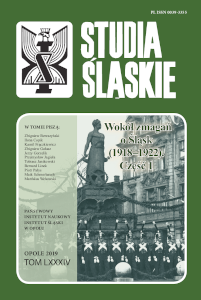Żołnierz, heros, kresowy rycerz – przemiana wizerunku „powstańca śląskiego” w międzywojennej rzeźbie monumentalnej
A soldier, a hero, a knight of Kresy borderland – the transformation of the image of a “Silesian insurgent” in the interwar monumental sculpture
Author(s): Jerzy GorzelikSubject(s): Politics / Political Sciences, Fine Arts / Performing Arts, Essay|Book Review |Scientific Life, Political history, Social history, Recent History (1900 till today)
Published by: Instytut Śląski
Keywords: Silesian Uprisings; monuments; Raszka; Zbigniewicz; Miszewski; Sanation
Summary/Abstract: After the May Coup and the appointment of Michał Grażyński – supported by the Union of Silesian Insurgents – as the voivode of the Silesian voivodeship, a new approach to the figure of a “Silesian insurgent” was marked in the monumental sculpture. It corresponded with the mythologisation of the Uprisings, which was accomplished in the Sanation propaganda. The Polish military actions in the years 1919–1921 were depicted as a spontaneous, liberating and victorious revolt of the “Upper Silesia folk” viewed as a homogenous entity, an outbreak consistent with the tradition of national uprisings, granting legitimacy not only to the Polish rule in Upper Silesia, but also to the special position of a chivalric insurgent in public life. This myth was applied instrumentally for the purpose of the fight, not only against Germans, but also against Korfanty’s Chadecja (Polish Christian Democratic Party). Korfanty would be depicted as a cunctator or even a traitor, whose weakness would contrast with the moral robustness of an insurgent-worker. In the Silesian voivodeship, the new image of an insurgent was formulated in the works by Stefan Zbigniewicz and Jan Raszka, sculptors related to Kraków. The former designed a monument in Królewska Huta, a city dominated by German minority, creating a figure of a muscular hero in a steelworker’s apron who held a freshly forged sword and faced the German border. Raszka used a more dynamic image in his relief in the edifice of the Silesian Parliament in Katowice and in his monument in Bogucice, presenting an insurgent-steelworker in the act of performing a mighty swing of a hammer. The artists emphasised the timelessness of the “insurgent deed” by rendering an aspect of antiquity and reference to the imagery of Vulcan and Hercules and to the chivalric ethos. It is to this new image of an insurgent that Antoni Miszewski referred in his decoration of the Governmental Palace during the Polish General Exhibition in Poznań in 1929, where the struggling for the Polish Upper Silesia was integrated into the political cult of marshal Józef Piłsudski. It was likewise evident in the monument designed by the Croatian sculptor Antun Augustinčić for Katowice.
Journal: Studia Śląskie
- Issue Year: 2019
- Issue No: 84
- Page Range: 57-75
- Page Count: 19
- Language: Polish

